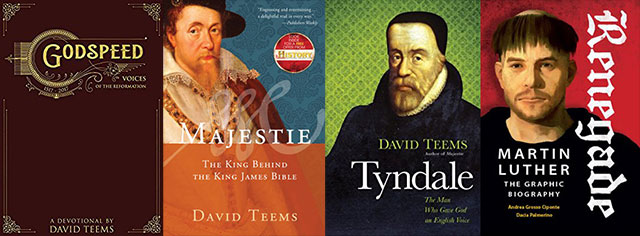Some Different Voices of the Reformation
Reformation late-comers.
By Jennifer Woodruff Tait
2017 has been so rich with Reformation-related resources that a few things that crossed my desk are coming somewhat late in the game. Nevertheless, I thought you all should know about them. When the spotlight moves somewhere else next year, they will still be well worth pondering.

First, just a few weeks ago, Abingdon Press sent me a little devotional drawn from the words of the reformers called Godspeed: Voices of the Reformation. It is edited by David Teems, who has written previously on William Tyndale and on the King James Bible, and even has a nice durable cover and a ribbon to make it practical to carry about and use for daily study.
Tyndale takes center stage here, but there are also a fair number of quotes from Luther and Calvin, from English reformers like Thomas Cranmer and Anne Askew, and assorted other voices that should be familiar to you by now from our four-issue series. By and large, they are Protestant voices, though I also spotted Erasmus and Savonarola. Some days simply feature an excerpt, some days a bit of history, some days Teems’ charmingly idiosyncratic reflections on the lessons he’s learned from the Reformers. As he says at the beginning: “This little book doesn’t pretend to be a history, and it doesn't always behave like a devotional.”
Just because the 500th anniversary of the Reformation is drawing to a close doesn’t mean the words of this little book are any less wise and interesting. You could begin reading on October 31 and go until you come back around, or you could start in January 2018. Whichever you choose, you’ll enjoy this very human look at our brothers and sisters in Christ in the 16th century.
Secondly, a bit longer ago, Plough Publishing favored me with a review copy of their graphic novel about the life of Luther, Renegade, by Andrea Grosso Ciponte and Dacia Palmerino, which releases officially this week. It may seem difficult to say anything new about Luther at this point, but this book manages to do it.
First, there is the sheer power of the art. Ciponte and Palmerino get the look and feel of the 16th century, and give us dark garrets, sumptuous palaces, and simple taverns. Their sometimes-disturbing images humanize Luther like few other things I have read recently. (Because they are sometimes disturbing, I’d rate the book PG-13, and recommend it for older teens or adults. There is no sex, but there is some violence, chiefly involving executions.) The text incorporates a lot of 16th-century primary sources by Luther and others.
They also carry the story all the way through from birth to death, although they move pretty abruptly from the Augsburg Confession to the death of Luther, a 16-year gap in which I would loved to have seen some of Martin and Katie's family life. They don’t mince criticisms of either medieval Catholicism or Luther. The Catholic targets are the obvious ones: Tetzel, Pope Leo, Emperor Charles V, and the like. But there is also a long section on Luther’s lack of support for the Peasants’ War and a shorter bit on his attitudes towards the Jews. Katherina Luther’s part is small, but dramatic and even funny (“I’d rather be mistaken for a herring than a nun”). I hardly ever cry, but I got choked up at both the Luthers’ wedding and Martin’s death.
The overall effect is contemplative, not triumphalistic, and I highly recommend it as we get launched towards 501 years since the 95 Theses. In the “if you only read one book about Luther this year” category, this has got to be near the top of the list. You should follow it up with some of the more in-depth treatments we mention in our Luther issue if you want more, but by reading this one you will definitely understand what all the fuss was about.



